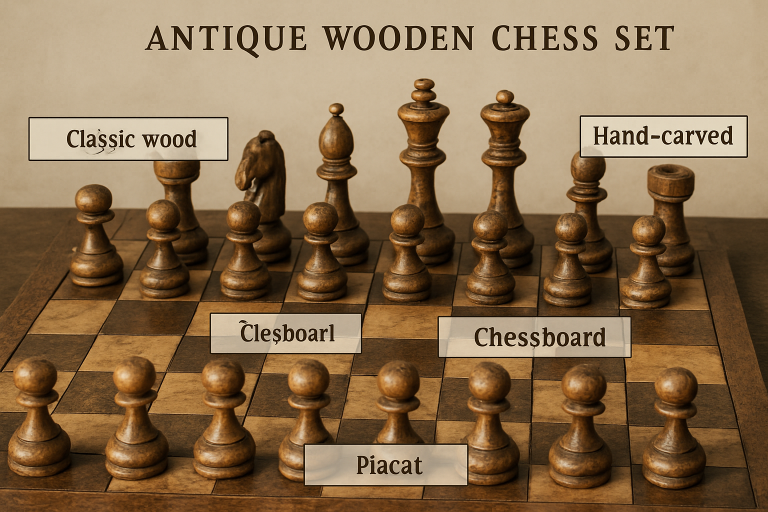Timeless Treasures: Why Collecting Antique Chess Sets Still Captivates Enthusiasts
Antique chess sets are more than playing pieces—they’re cultural artifacts capturing history, artistry, and ingenuity. From carved knights to rare materials like ivory, ebony, or sandalwood, each reflects its era’s craftsmanship and values. Collectors are attracted not just to their beauty but also to the stories they hold—linked to royal courts, famous matches, or regional traditions. Even in a digital age, these sets fascinate enthusiasts worldwide, blending strategy, heritage, and timeless design that sustain collecting passion.
The Heritage Behind Antique Chess Sets
Collecting antique chess sets is more than gathering game pieces. Each set reflects its era’s culture and craftsmanship. Many trace back centuries, linking collectors to legendary players, artisans, and key historical moments. This is especially true of British designs; British chessmen remain one of the most coveted and historically significant categories for those curious about the hallmark styles. Collectors prize these items for their beauty, rarity, and ability to evoke a bygone era with carved details. Antique chess sets tell intriguing stories; those surviving wars, gifted diplomatically, or involved in social events gain significance, with provenance adding charm. Holding a Victorian or Russian noble’s set feels like touching history. Nicks, patina, and wear reveal stories, connecting past and present.
Materials and Craftsmanship: Markers of Value
An antique chess set’s value is determined by its materials and craftsmanship, with rare woods like boxwood, ebony, and rosewood, as well as elements like ivory, bone, or mother-of-pearl. These sets reflect the resources, tech, and style of the era, and are hand-carved and finished, unlike mass-produced reproductions. Collectors value quality and artistry, distinguishing factory-made from authentic ones.

Popular Styles and Periods for Collectors
Antique chess sets come in various styles and periods, with the Staunton pattern being popular for its ergonomic design. Collectors also seek rare items like Persian or Indian sets with carved elephants, English Barleycorn pieces, or Russian collections. Each era offers distinct aesthetics, helping buyers identify authentic antiques and build collections that tell stories across eras and regions.
What Drives People to Collect Chess Antiques?
The motivations for collecting antique chess sets are as varied as the pieces. For some, it is a passion rooted in the intellectual allure of chess combined with an appreciation for history and artwork. For others, collecting is seen as an investment—a tangible asset with the potential for long-term growth in value. Emotional factors also play a role; inheriting a set from a beloved relative or adding a scarce find to one’s collection can create a sense of legacy and personal pride.
Authentication and Appraisal: Protecting Your Investment
Ensuring the authenticity of an antique chess set is crucial. Provenance—the documented history of an object’s ownership—can significantly affect price and desirability. Experienced collectors consult reputable dealers, professional appraisers, and established auction houses to authenticate potential acquisitions. Recognizing genuine antiques involves carefully examining patina, tool marks, materials, and period-specific construction methods. Increasing sophistication in replica production makes ongoing education even more critical for collectors hoping to safeguard their investments.
Preserving Antique Chess Sets for Future Generations
Avoid direct sunlight, use gentle cleaning agents to preserve an antique chess set, and store pieces in padded containers or well-ventilated display cases. Regular maintenance ensures the set’s beauty and function, preserving its educational value for future generations. Avoid harsh chemicals and store pieces in well-ventilated cases to prevent chipping, moisture, and dust accumulation.
Community and Resources for Chess Collectors
The chess collecting community is vibrant, welcoming both newcomers and seasoned enthusiasts. Participation in forums, exhibitions, and clubs provides access to specialist knowledge, alerts about auctions, and opportunities to connect with like-minded individuals. Engaging with these communities helps collectors refine their expertise and inspires a deeper appreciation for the artistry and history of chess sets.
The Global Phenomenon of Chess Collecting
Chess collecting is a shared passion, drawing interest from diverse cultures and backgrounds. International exhibitions and auctions command global attention, creating a lively marketplace where rare and valuable pieces circulate among collectors. The universal appeal of chess and its historic artifacts is a powerful force for cultural exchange, as highlighted by coverage in respected international publications.
Conclusion: The Enduring Allure of Chess Antiques
Collecting antique chess sets is a pursuit where aesthetics, intellect, and historical wonder converge. From the elegant sweep of British Staunton pieces to the intricate carvings of far-off cultures, these objects offer more than a pastime—they are living relics, continuing to enchant collectors and admirers across generations. For anyone drawn to art, history, or the timeless challenge of chess, the allure of antique sets will never fade.

